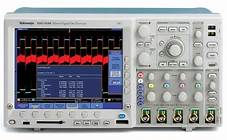What is an Oscillator?
What is an Oscillator?
- The oscilloscope is basically a graph-displaying device
- It draws a graph of an electrical signal.
- In most applications the graph shows how signals change over time: Vertical (Y) axis represents voltage and horizontal (X) axis represents time.
The oscillator is a circuit that generates a continuous, repeated, alternating waveform without any feedback. Oscillators effectively transform the unidirectional current flow from the DC source to the alternating waveform of the desired frequency as defined by the circuit components.
The basic theory behind the operation of the oscillators can be understood by observing the behaviour of the LC tank circuit shown in Figure 1 below, which uses the L inductor and the totally pre-charged C capacitor as its elements. Here, at first, the capacitor begins to discharge from the inductor, which results in the transfer of the electrical energy into the electromagnetic field that can be contained in the inductor. If the capacitor is completely discharged, there would be no current flow.
By then, however, the retained electromagnetic field would have created a back-emf, which would result in the current movement through the circuit in the same direction as before. This current movement through the circuit continues until the electromagnetic field collapses, which causes the electromagnetic energy to be transformed back into electrical form , allowing the loop to replicate itself. Now, however, the capacitor would have charged the opposite polarity, which would have caused an oscillating wave.
However, the oscillations that occur as a result of the interconversion between the two sources of energy can not proceed indefinitely, as they will be exposed to the effect of energy loss due to the resistance of the circuit. As a result, the amplitude of these oscillations is gradually decreasing to zero, which makes them moist in nature.
This means that, in order to achieve continuous and steady amplitude oscillations, one must compensate for the lack of energy. It should be remembered, however, that the energy supplied should be precisely regulated and equal to the energy lost in order to achieve constant amplitude oscillations.
This is because, if the energy supplied is more than the energy lost, then the amplitude of the oscillations will increase while if the energy supplied is less than the energy lost, then the amplitude of the oscillations will decrease
Practically, oscillators are nothing but amplifier circuits provided with constructive or regenerative feedback where part of the output signal is fed back to the input . In this case, the amplifier consists of an active amplifying element that may be a transistor or an Op-Amp and the back-feed in-phase signal is kept responsible for preserving (sustaining) the oscillations by making up for circuit losses.
Once the power supply is switched ON, the oscillations will be initiated in the system due to the electronic noise present in it. This noise signal travels around the loop, gets amplified and converges to a single frequency sine wave very quickly. The expression for the closed-loop gain of the oscillator
Where A is the voltage gain of the amplifier and β is the gain of the feedback network. Here, if Aβ > 1, then the oscillations will increase in amplitude while if Aβ < 1, then the oscillations will be damped . On the other hand, Aβ = 1 leads to the oscillations which are of constant amplitude . In other words, this indicates that if the feedback loop gain is small, then the oscillation dies-out, while if the gain of the feedback loop is large, then the output will be distorted; and only if the gain of feedback is unity, then the oscillations will be of constant amplitude leading to self-sustained oscillatory circuit.
Performance Terms for Oscillator
Bandwidth
The bandwidth specification tells you the frequency range the oscilloscope accurately measures.
Rise Time
Rise time may be a more appropriate performance consideration when you expect to measure pulses and steps. An oscilloscope cannot accurately display pulses with rise times faster than the specified rise time of the oscilloscope.
Vertical Sensitivity
The vertical sensitivity indicates how much the vertical amplifier can amplify a weak signal. Vertical sensitivity is usually given in millivolts (mV) per division.
Sweep Speed
For analog oscilloscopes, this specification indicates how fast the trace can sweep across the screen, allowing you to see fine details. The fastest sweep speed of an oscilloscope is usually given in nanoseconds/div.
Gain Accuracy
The gain accuracy indicates how accurately the vertical system attenuates or amplifies a signal.
Time Base or Horizontal Accuracy
The time base or horizontal accuracy indicates how accurately the horizontal system displays the timing of a signal.
Sample Rate
On digital oscilloscopes, the sampling rate indicates how many samples per second the ADC can acquire. Maximum sample rates are usually given in megasamples per second (MS/s). The faster the oscilloscope can sample, the more accurately it can represent fine details in a fast signal..
ADC Resolution (Or Vertical Resolution)
The resolution, in bits, of the ADC indicates how precisely it can turn input voltages into digital values.
Record Length
The record length of a digital oscilloscope indicates how many waveform points the oscilloscope is able to acquire for one waveform record.
Types of oscillators
Oscillators are categorized based on the signal they produce.
- Sine wave oscillator– Produces sine waves
- Relaxation oscillator– Produces square and rectangular waves
- Sweep wave oscillator– Produces sawtooth waves

